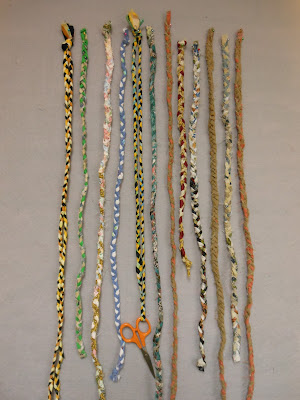This series of posts on challenges has finally made its way full circle back to where it started: my response to a new SAQA show that will be called "Text Messages."
SAQA has been particularly energetic in the last year or so in organizing theme shows that will travel around the country and be documented in catalogs. I think this is an excellent idea and at least in my book, the most valuable service the organization provides to its members. I have read many calls for entries for these shows and decided not to participate.
For instance, the "Beyond Comfort" exhibit had to do with "new technologies, techniques and materials." Not my thing. "Layers of Memory" had to do with memory, a subject I had worked with in 2001 and 2002 (my company had offices in the World Trade Center and I spent a lot of time in that building, so my response to its destruction had a lot to do with my own memories) but which I was no longer actively exploring. "Art Meets Science" and "A Sense of Humor" didn't strike any chords. And several other shows just didn't relate to what I was interested in.
But "Text Messages" is a subject that calls out to me in 144-point boldface all caps. I could probably write a book about my affinity with text as a visual artist -- and now that I mention it, maybe I will write about it for you in the coming weeks. For now, let me say that text, in the form of letterforms and alphabets, has been a huge element in my work for at least a decade.
So the thought of making quilts with "actual or implied writing" struck so close to my heart that I had to do something to enter this show.
I wrote last month about quilt #1, which I began several years ago and hope to finish in the next couple of weeks. Now I've almost finished quilt #2.
I came to be the owner of a large piece of fabric covered with black printing on white background. I think it had been a curtain in its first career, because of the hems and the permanently embedded creases, and I have no recollection of how it came to me. The printing was attractive but apparently the writing was commissioned from terminally stupid Valley Girls. So if I were to ever use the fabric, I'd have to cut it into small enough pieces that the words wouldn't be embarrassing.
Well, not to worry -- my current "Crazed" series of quilts, now up to #20, uses fabric cut into small pieces, generally no larger than postage stamps. I have been wanting to do more with pieced fine lines cut from striped fabric. I have used striped lines -- actually they look more like dotted lines when they're less than an eighth-inch wide -- in five quilts so far, and don't think I've even scratched the surface yet.
So it was totally comfortable to make a quilt using the printed text as background and striped fabrics as pieced-in lines. The fact that it met the criteria for the SAQA show was almost incidental. Here's a detail shot:
Crazed 20: Print on the Dotted Line




























































